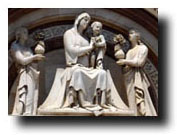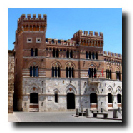|
|
|
Until only a few decades ago this was an important mining area and, in fact, the entrances to the mines are still clearly visible. The walls of the castle of Gavorrano are still recognisable while inside the town walls there are several important medieval buildings whose original structure has been preserved. The “new” parish church, built at the end of the 18th century, is also of great interest and contains a sculpture of the Madonna with Child by the 15th century sculptor from Siena, Giovanni d’Agostino.
|
|

|
|
This
is the capital town of the Tuscan Maremma and its origins are
Etruscan-Roman. In the late Middle Ages it belonged to the
Aldobrandeschi family. Subsequently it broke free from imperial
rule and became a “Comune”, or free city, for a brief period
before being conquered by Siena and then ruled the Medici family
in 1559. After a period of decline the arrival of the Lorena
family (18th century) brought a new lease of life to the area. The
swamps and marshy plains were drained and reclaimed thanks to the
works commissioned by Grand Dukes Pietro  Leopoldo,
Ferdinando III and Leopoldo II. The historic centre of Grosseto is surrounded by a circuit of Medicean walls (16th century) on a hexagonal base with watch stations. Leopoldo,
Ferdinando III and Leopoldo II. The historic centre of Grosseto is surrounded by a circuit of Medicean walls (16th century) on a hexagonal base with watch stations.
 One of these watch points is the magnificent Fortezza which houses the monumental Cassero. In the central square, Piazza Duomo, stands the Cathedral dedicated to the city’s patron saint One of these watch points is the magnificent Fortezza which houses the monumental Cassero. In the central square, Piazza Duomo, stands the Cathedral dedicated to the city’s patron saint
 San Lorenzo, built probably in the 12th century on the ruins of the previous Church of Santa Maria. Also interesting is the Church of San Francesco built in the 13th century on the ruins of an old Benedictine monastery. The Church of San Pietro, dating approximately to the 9th-10th century, was built on a late imperial building. San Lorenzo, built probably in the 12th century on the ruins of the previous Church of Santa Maria. Also interesting is the Church of San Francesco built in the 13th century on the ruins of an old Benedictine monastery. The Church of San Pietro, dating approximately to the 9th-10th century, was built on a late imperial building.
|
|

|
|
The Island of Giannutri covers approximately 260 hectares and is the Tuscan archipelago’s most southern island. Its rocky coast is interrupted by only two beaches: Cala del Spalmatoio to the north-east and Cala Maestra to the north-west. The coastal caves scattered along the rocks are extremely interesting; the most famous is Cala dei Grottini on the island’s rocky southern coast.
|
|

|
|
|